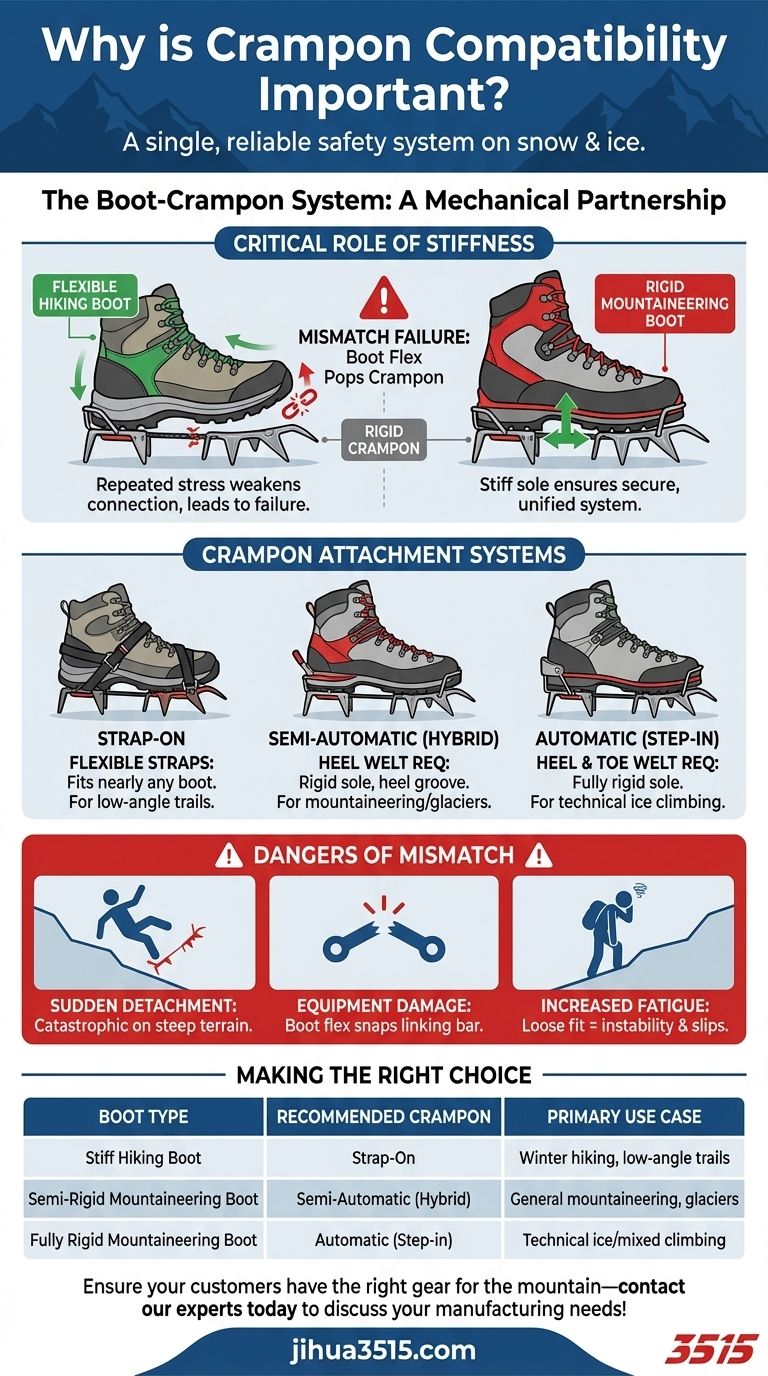Crampon compatibility is the single most important factor for safety when using hiking boots on snow and ice. It isn't just a feature; it's a structural requirement that ensures your boot and crampon function as a single, reliable system. A mismatch between the two can lead to catastrophic failure on dangerous terrain, where secure footing is the only thing preventing a serious fall.
A boot and a crampon are not separate pieces of gear—they are two halves of a single safety system. Compatibility ensures this system works as one, providing the reliable traction and support needed on hazardous terrain where equipment failure is not an option.

The Boot-Crampon System: A Mechanical Partnership
To understand compatibility, you must stop seeing boots and crampons as independent items. Instead, think of them as a cohesive unit designed for a specific purpose.
The Critical Role of Boot Stiffness
The core of compatibility is the rigidity of the boot's sole. Standard hiking boots are designed to flex with your foot for comfort while walking. Crampons, however, are made of metal and are either semi-rigid or fully rigid.
When you put a rigid crampon on a flexible boot, every step you take causes the boot to bend away from the crampon. This repeated stress weakens the connection and will inevitably lead to failure.
How Different Crampons Attach
The method of attachment is directly tied to the boot's design. There are three main systems:
- Strap-on: Uses flexible webbing straps to attach to nearly any boot.
- Semi-automatic (Hybrid): Uses a lever at the heel and a basket at the toe. Requires a boot with a rigid sole and a dedicated "welt" or groove on the heel.
- Automatic (Step-in): Uses a lever at the heel and a wire bail at the toe. Requires a fully rigid boot with both heel and toe welts.
Why a Mismatch Creates a Failure Point
Attempting to mount a semi-automatic or automatic crampon on a boot without the proper stiffness and welts is like trying to attach a ski binding to a running shoe. The system isn't designed for it.
The connection will be loose and unstable from the start. Under the load of your body weight on steep terrain, the boot's flex will "pop" the crampon off, leading to a sudden and complete loss of traction.
Understanding the Trade-offs and Dangers
Choosing an incompatible system isn't just inefficient; it is actively dangerous. The consequences of a mismatch range from equipment damage to life-threatening falls.
The Primary Danger: Sudden Detachment
This is the most critical risk. When your boot flexes, it can easily force the crampon's heel lever to unlock or the toe bail to slip.
This detachment happens without warning. One moment you have a secure purchase on ice, and the next you have none. On a low-angle slope, this may be an inconvenience. On a steep, exposed snow or ice face, it is a catastrophic failure.
Risk of Equipment Damage
The force of a flexing boot against a rigid crampon puts immense strain on the linking bar that connects the front and back pieces. This can bend or even snap the bar, rendering the crampon useless.
Increased Fatigue and Poor Performance
Even if the crampon doesn't detach completely, an improper fit creates movement between the boot and the crampon. Your foot will be working harder to maintain stability, leading to much faster fatigue and a higher risk of slips.
Making the Right Choice for Your Goal
Your choice must be dictated by your objective. Match the boot and crampon system to the demands of the terrain.
- If your primary focus is winter hiking on low-angle trails: A stiff hiking boot paired with a flexible, strap-on crampon provides adequate security.
- If your primary focus is general mountaineering on glaciers or steep snow: You require a semi-rigid mountaineering boot with a heel welt and a compatible semi-automatic crampon.
- If your primary focus is technical ice or mixed climbing: Only a fully rigid boot with toe and heel welts, paired with an automatic crampon, will offer the necessary performance and safety.
Ultimately, treating your boots and crampons as an inseparable system is the foundation of safe and efficient travel in the mountains.
Summary Table:
| Boot Type | Recommended Crampon Type | Primary Use Case |
|---|---|---|
| Stiff Hiking Boot | Strap-On | Winter hiking on low-angle trails |
| Semi-Rigid Mountaineering Boot | Semi-Automatic (Hybrid) | General mountaineering, glaciers, steep snow |
| Fully Rigid Mountaineering Boot | Automatic (Step-in) | Technical ice climbing, mixed climbing |
As a large-scale manufacturer, 3515 produces a comprehensive range of footwear for distributors, brand owners, and bulk clients. Our production capabilities encompass all types of safety-focused shoes and boots, including models designed for reliable crampon compatibility. Ensure your customers have the right gear for the mountain—contact our experts today to discuss your manufacturing needs!
Visual Guide

Related Products
- Wholesale High-Traction Camo Boots - Custom Manufacturer for Brands
- Factory-Direct Wholesale Canvas Boots with High-Traction Rubber Soles
- Premium Wholesale Waterproof Safety Boots High Performance Protection for Industrial Markets
- High Performance Fire-Retardant Waterproof Safety Boots
- Customizable Anti-Smash Safety Boots for Wholesale & Private Label Manufacturing
People Also Ask
- Why might wearing multiple pairs of socks be counterproductive? Avoid This Common Cold-Weather Mistake
- What historical event marked the first use of camouflage in military apparel? The Napoleonic Wars' Tactical Shift
- How is PVC produced? From Salt & Gas to a Versatile Polymer
- What are the key features of the new line of camo boots? Built for Extreme Cold & Rugged Terrain
- What technologies are used in the men's 8-inch camo lace-up boots? A Guide to Rugged Outdoor Performance



















